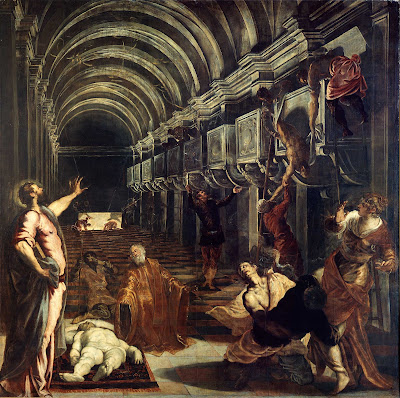Discovery of the Body of Saint Mark
The first catalog of Holy Days comes from the Decree of Gratian in c. 1150 AD, which shortly thereafter gave way to Decretals of Pope Gregory IX in 1234, which listed 45 Holy Days. In 1295, Pope Boniface VIII enacted the decretal Gloriosus which "commanded that each of the feasts of the twelve apostles, four evangelists, and four doctors of the Church be celebrated as an officium duplex" (The Cambridge History of Medieval Canon Law by Anders Winroth and John Wei).
In 1642, His Holiness Pope Urban VIII issued the papal bull Universa Per Orbem which mandated the required Holy Days of Obligation for the Universal Church to consist of 34 days as well as the principal patrons of one's one locality (e.g. city and country). Those days were the Nativity of Our Lord, the Circumcision of Our Lord, the Epiphany of Our Lord, Monday within the Octave of the Resurrection, Tuesday within the Octave of the Resurrection, Ascension Thursday, Monday within the Octave of Pentecost, Tuesday within the Octave of Pentecost, Most Holy Trinity, Corpus Christi, the Finding of the Holy Cross, the Purification of the Blessed Virgin Mary, the Annunciation of the Blessed Virgin Mary, the Assumption of the Blessed Virgin Mary, the Nativity of the Blessed Virgin Mary, the Dedication of St. Michael, the Nativity of St. John the Baptist, SS. Peter and Paul, St. Andrew, St. James, St. John (the December feast day), St. Thomas, SS. Philip and James, St. Bartholomew, St. Matthew, SS. Simon and Jude, St. Matthias, St. Stephen the First Martyr (the December feast day), the Holy Innocents, St. Lawrence, St. Sylvester, St. Joseph, St. Anne, and All Saints.
Ultimately Universa Per Orbem helped bring more uniformity to the Church since some parts of the Catholic world observed even more holy days of double precept (i.e., mandatory attendance at Mass and rest from servile work). One of those former days which kept in some places as the Feast of St. Mark the Evangelist.
For instance, in modern-day Texas, New Mexico, Arizona, and California, which were included in the ecclesiastical province of Mexico, the feasts were regulated by the Third Council of Mexico in 1585, as American Catholic Quarterly Review states:
"In these parts besides those already mentioned, the faithful observed as holy days of obligation St Fabian and St Sebastian (January 20th), St Thomas Aquinas (March 7th), St Mark (April 25th), St Barnabas (June 1), the Visitation of the Blessed Virgin (July 2), St Mary Magdalene (July 22), St Dominic (Aug 4), the Transfiguration (Aug 6), St Francis (Oct 4), St Luke (Oct 18), St Catharine (Nov 25), the Expectation of the Blessed Virgin (Dec 18).
And while our ancestors in the New World in Florida and Louisiana would not have kept St. Mark's Day as a Holy Day of Obligation, it was kept as a day of abstinence from meat on account of it being the Major Rogation Day. See A History of Holy Days of Obligation & Fasting for American Catholics for more information on this forgotten history. The same can be said for English Catholics who were bound to abstain from fleshmeat on the Major and Minor Rogation Days until they were dispensed by Pope Pius VIII in 1830 (A Catholic Dictionary from 1893 by William Edward Addis).
Thus this year, on April 25th, in addition to praying the Litany of the Saints for the Rogation Day and observing abstinence, let us honor the memory of St. Mark by reading his Gospel and by attending the Holy Sacrifice of the Mass.








0 comment(s):
Post a Comment